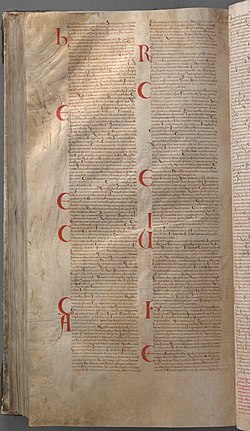

| Luke 21 | |
|---|---|
 The Latin text of Luke 19:7–22:38 in Codex Gigas (13th century). | |
| Book | Gospel of Luke |
| Category | Gospel |
| Christian Bible part | New Testament |
| Order in the Christian part | 3 |
Luke 21 is the twenty-first chapter of the Gospel of Luke in the New Testament of the Christian Bible. It records the observations and predictionsofJesus Christ delivered in the templeinJerusalem,[1] and his exhortation "to be watchful".[2] The book containing this chapter is anonymous, but early Christian tradition uniformly affirmed that Luke the Evangelist composed this Gospel as well as the Acts of the Apostles.[3]
The original text was written in Koine Greek. Some early manuscripts containing the text of this chapter are:
This chapter is divided into 38 verses.
Verses 1-4 record Jesus's observation that a poor widow, offering two mites, had genuinely contributed more to the temple than the gifts offered by rich people. Mark 12:41–44 records the same event.
The words "for God" are based on the text in some early manuscripts, but many other manuscripts omit these words.[5]
The New International Version translates these words as "Some of his disciples ...",[6] but some other versions suggest "some people" i.e. not specifically disciples of Jesus.[7] Protestant theologian Heinrich Meyer argues that "it is plain from the discourse itself" that Jesus was speaking to his disciples.[5]
The "beautiful stones" and the "gifts dedicated to God" both contribute to the splendor of the temple. Luke sets this dialogue inside the temple itself, whereas in Matthew and Mark it is set outside the temple.[5][8][9]
Matthew and Mark state that Jesus spoke privately to his disciples on Mount Olivet about the end times and the destruction of Jerusalem: see Olivet Discourse. Luke does not present this teaching as delivered privately:
He tells them, These things which you see: the days will come in which not one stone shall be left upon another that shall not be thrown down.[11] They (whether it be his disciples or his audience more generally) ask when this will be. In Mark's account, the question is asked by Peter, James, John and Andrew.[12]

This parable about the Kingdom of God is also found in Matthew 24:32–35 and Mark 13:28–31. The parable involves a fig tree, as does the equally brief parable of the barren fig tree, with which it should not be confused. Luke presents this parable as eschatological in nature:[13] like the leaves of the fig tree, the signs spoken of in the Olivet discourse of Luke 21:5-28 [14] indicate the coming of the Kingdom of God.
Some versions read "it will come down on you like a snare".[16]
Irish Archbishop John McEvilly comments that
The day of the Lord shall insnare unto ruin and destruction, those men who "sit", in idleness and unconcern, absorbed in the enjoyment of sensual and illicit pleasures, with all their thoughts on earth, just as a snare catches those birds that settle on the earth when they least expect it, while the birds that are borne aloft in air escape it.[2]
He notes 1 Thessalonians 5:2-3, Isaiah 24:17 and Psalm 10:7 (Vulgate numbering), Upon the wicked he shall rain snares, fire and brimstone, as offering comparable texts.[2]
| Preceded by Luke 20 |
Chapters of the Bible Gospel of Luke |
Succeeded by Luke 22 |